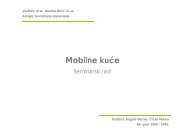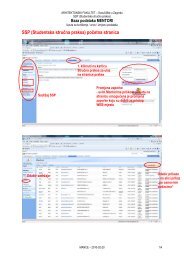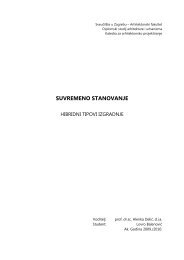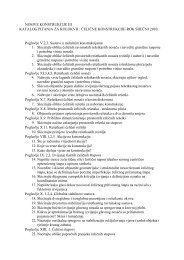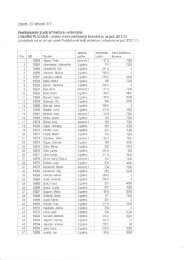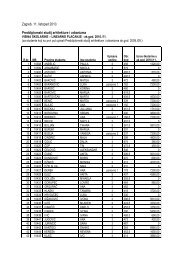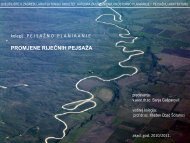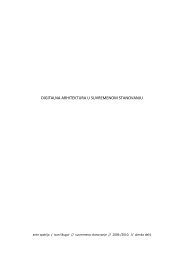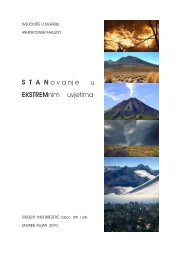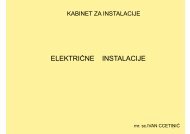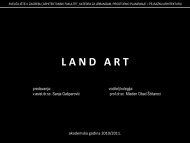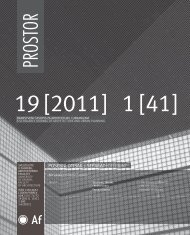BODEGA
BODEGA
BODEGA
Create successful ePaper yourself
Turn your PDF publications into a flip-book with our unique Google optimized e-Paper software.
<strong>BODEGA</strong><br />
ENOLOGICAL METABOLISM<br />
AA VISITING SCHOOL BARCELONA
2<br />
A
TABLE OF<br />
CONTENTS<br />
3<br />
Outline<br />
BARCELONA 05<br />
BRIEF 07<br />
DIAGRAM 09<br />
ACADEMIC AGENDA 11<br />
LECTURES 14<br />
FIELDWORK 15<br />
FACULTY 16<br />
SPONSORS 19<br />
PROGRAMME 13<br />
FRONT Oak barrels at the aging room at SALA<br />
FERUSIC’s work “¿Menos da una piedra<br />
Lagravera Winery”. Photograph by Relja Ferusic<br />
BACK Panoramic night shot of the city of<br />
Barcelona. Photograph by Relja Ferusic<br />
A Vineyard in autumn at MAS RODÓ Vitivinícola<br />
Estate in Mediona, Alt Penedès. Barcelona Spain.<br />
Photograph by Carles Sala.
4<br />
A<br />
<strong>BODEGA</strong> Enological Metabolism
BARCELONA<br />
5<br />
AA Visiting School<br />
The purpose of this document is to bring the AA School the chance<br />
to travel for the first time to the Mediterranean city of Barcelona, a city with the<br />
perfect architectural environment and legacy for an AA Visiting School.<br />
The ETSAB, ‘Escola Tècnica Superior d’Arquitectura de Barcelona’,<br />
will become the local and collaborative school for the AA Visiting School<br />
Barcelona. The school of Gaudí, Domènech i Montaner, Coderch, Bonet<br />
Castellana, Sert, Miralles, Llinàs, Moneo, Mateo or Ferrater will bring its long<br />
expertise and resources to achieve the appropriate academic environment<br />
for the course, under the umbrella of the UPC - BarcelonaTECH, ‘Universitat<br />
Politècnica de Catalunya’.<br />
<strong>BODEGA</strong><br />
Enological Metabolism<br />
AA Visiting School Barcelona<br />
From the 12th to the 26th of July 2013<br />
UPC - BarcelonaTECH<br />
Universitat Politècnica de Catalunya<br />
“ETSAB, the school of<br />
Gaudí, Sert, Miralles,<br />
Llinàs, Moneo, Mateo or<br />
Ferrater, will become the<br />
local and collaborative<br />
school for the AA Visiting<br />
School Barcelona.”<br />
AA School of Architecture<br />
Architectural Association<br />
London<br />
ETSAB<br />
Escola Tècnica Superiot d’Arquitectura<br />
Barcelona<br />
B<br />
C<br />
A Aerial photograph of the city of Barcelona.<br />
B ETSAB, Escola Tècnica Superior d’Arquitectura<br />
de Barcelona. Work by the Catalan architect<br />
Josep Antoni Corderch.<br />
C ETSAB school’s working studio, insode the<br />
building designed by Coderch.<br />
AA School of Architecture<br />
Architectural Association London<br />
Escola Tècnica Superior<br />
d’Arquitectura de Barcelona<br />
AA Visiting School Barcelona
6<br />
A<br />
<strong>BODEGA</strong> Enological Metabolism
BRIEF<br />
7<br />
Bodega, Enological Metabolism<br />
Spain’s great heritage and tradition on wine production has led the<br />
country to become the world’s first region in vineyard extension and, as a<br />
result, the pursuit for quality is already an obsession for many wineries to gain a<br />
foothold in the international market. In turn, a very accurate set of methods and<br />
techniques are currently being implanted to ensure a full control over the whole<br />
process of wine making as means of optimization in design for enologists.<br />
Relying on the use of digital diagramming and mapping, we will unfold<br />
the metabolism of wine production and dissect techniques and technologies<br />
involved in the processes. Underlining the characteristics of time information<br />
and feedback, we will recognize the potential of the use of Control Systems as<br />
an essential design tool.<br />
“We will unfold the<br />
metabolism of wine<br />
production and dissect<br />
techniques and<br />
technologies involved in<br />
the processes”<br />
Concluding the research with an internal presentation, we will address<br />
the spatial and organizational attributes of the process to envisage, through<br />
the production of drawings, digital and physical models, potential architectural<br />
solutions for a contemporary bodega.<br />
B<br />
D<br />
B<br />
E<br />
A Fermentation room at SALA FERUSIC’s work<br />
“¿Menos da una piedra Lagravera Winery”.<br />
B Working processes inside Lagravera Winery to<br />
produce wine, by using all sorts of technological<br />
means.<br />
C-D Grape harvest in Mas Rodó Vitivinícola, in<br />
late summer.<br />
E Vineyard in Mas Rodó Vitivinícola in autumn.<br />
Each variety can be appreciated as they evolve at<br />
various times and their colors appear different.<br />
C<br />
AA Visiting School Barcelona
8<br />
DIAGRAM<br />
Graphical Representation of Parties<br />
PRIVATE<br />
FOUNDATION<br />
B<br />
PRIVATE<br />
FOUNDATION<br />
A<br />
Site A<br />
SAGRADA FAMÍLIA<br />
The tours around the city will<br />
include a visit to Antoni Gaudí’s<br />
Sagrada Família. A local<br />
architect will take us to the<br />
construction site and explain it<br />
from the cranes and the<br />
non-visible areas which still<br />
remain closed for the general<br />
public.<br />
Barcelona<br />
FIELDWORK<br />
Countryside<br />
Sponsor<br />
Architecture<br />
Site B<br />
MEDIA-TIC<br />
Another tour to a new reknown<br />
building will be scheduled during<br />
the workshop period. Its author<br />
will lead and explain the students<br />
how it was conceived, designed<br />
and built. A proposal for this tour<br />
could be the Media-TIC building<br />
by Cloud9 (Enric Ruiz-Geli).<br />
Visiting School<br />
AA School<br />
ARCHITECTURAL ASSOCIATION<br />
AA is the leading educational and<br />
research organizationfor in the field of<br />
advanced architecture, outlining the<br />
future of the built environment.<br />
AA Visiting School is a powerful<br />
education platform operating in multiple<br />
locations over the world. AA is acting<br />
as a Visiting School for the “<strong>BODEGA</strong>”<br />
workshop.<br />
AA Visiting School<br />
Barcelona<br />
ARCHITECTS<br />
<strong>BODEGA</strong><br />
ENOLOGICAL METABOLISM<br />
Spain’s great heritage and tradition on wine production has led the country to<br />
become the world’s first region in vineyard extension and, as a result, the<br />
pursuit for quality is already an obsession for many wineries to gain a foothold in<br />
the international market. In turn, a very accurate set of methods and techniques<br />
are currently being implanted to ensure a full control over the whole process of<br />
wine making as means of optimization in design for enologists.<br />
Relying on the use of digital diagramming and mapping, we will unfold the<br />
metabolism of wine production and dissect techniques and technologies<br />
involved in the processes. Underlining the characteristics of time information<br />
and feedback, we will recognize the potential of the use of Control Systems as<br />
an essential design tool.<br />
Concluding the research with an internal presentation, we will address the<br />
spatial and organizational attributes of the process to envisage, through the<br />
production of drawings, digital and physical models, potential architectural<br />
solutions for a contemporary bodega.<br />
Winery A<br />
MAS RODÓ OR LAGRAVERA<br />
Private Companies<br />
A<br />
INDUSTRY<br />
COMPANY<br />
A<br />
Several brand new local wineries<br />
could organize “in situ” tours for<br />
students of the workshop.<br />
The daily work in the winery and<br />
the practical aproach to the<br />
processes and technologies will<br />
be exposed to the students.<br />
INDUSTRY<br />
COMPANY<br />
B<br />
Sponsor<br />
Winery B<br />
CODORNIU OR TORRES<br />
Some traditional wineries could<br />
become the location and case<br />
study for this workshop. They<br />
could provide the students a<br />
great knowledge on traditional<br />
techniques and new introduced<br />
technologies and support the<br />
workshop from their deep<br />
understanding on this field.<br />
Technology<br />
ENGINEERS<br />
URV<br />
ENOLOGICAL RESEARCH<br />
Universitat Rovira i Virgili could<br />
provide the workshop with the<br />
know-how on wine technology<br />
and science fields. Professors<br />
could lecture whereas students<br />
on Enology or Agricultural<br />
Engineering could join the course<br />
Supporting Research Institution<br />
ENOL<br />
<strong>BODEGA</strong> Enological Metabolism
9<br />
Local School<br />
ETSAB<br />
UPC BarcelonaTECH<br />
DESIGN<br />
INSTITUTION<br />
Sponsor<br />
CROWD<br />
FUNDING<br />
ETSAB is a leading school of architecture<br />
in Catalonia, with highly renowned<br />
educational program and academic<br />
staff.<br />
It is a default place for most international<br />
researchers in the field of<br />
architecture. ETSAB is acting as a<br />
hosting school for the “<strong>BODEGA</strong>”<br />
workshop.<br />
Design<br />
COAC<br />
COL.LEGI ARQUITECTES<br />
The Col.legi Oficial d’Arquitectes<br />
de Catalunya, COAC, is the<br />
offcial institution that represents<br />
the architectural profession at all<br />
levels. COAC could promote and<br />
provide a network of professionals<br />
and potential sponsors to<br />
support the workshop.<br />
D HUB<br />
BARCELONA<br />
Design and Art Institutions such<br />
as the D Hub Barcelona, FAD<br />
(Fostering Arts and Design) or<br />
Centre d’Art Santa Mònica could<br />
strengthen the network in terms<br />
of communication and interdiciplinarity<br />
of the workshop, as well<br />
as to support it at other levels.<br />
Barcelona<br />
LECTURES<br />
Countryside<br />
OGISTS<br />
Public Institutions<br />
D.O.<br />
APPELATION DOMAINS<br />
DO are the appelation domains<br />
which also work as associations<br />
of wine producers and wineries<br />
located in certain areas. They<br />
could provide with updated<br />
information about the wine<br />
making technologies and<br />
systems used in those areas.<br />
Science<br />
Sponsor<br />
Enoturisme<br />
PENEDÈS<br />
Enoturisme Penedès is the<br />
association of wine makers and<br />
wineries which promote the wine<br />
tourism around the Penedès<br />
area. The association could<br />
facilitate information and<br />
resources to move the students<br />
around the area.<br />
AGRICULTURAL<br />
ASSOCIATION<br />
WINE<br />
INSTITUTION<br />
AA Visiting School Barcelona<br />
A Diagram of all parties involved in the AAVS<br />
Barcelona. This graphical representation shows<br />
the role of the two schools involved, the visiting<br />
school AA and the local school ETSAB, as well<br />
as the collaboration of a third party concerning<br />
research in agricultural engineering and enology,<br />
the URV. Several Institutions at both levels,<br />
Design and Wine promotion, will be involved and<br />
strengthen the course by offering lectures and<br />
support of all kinds. The AAVS will also do some<br />
fieldwork in local wineries as well as in signifficant<br />
buildings around the city of Barcelona.
10<br />
ACADEMIC<br />
AGENDA<br />
Methodology and Outputs<br />
The workshop is an investigation in the very metabolism of Enological,<br />
in other words the development of an understanding of the entire process of the<br />
production of wine which will enable to envision the design of a contemporary<br />
winery.<br />
Wine is the object of a field of science and technology; the<br />
characteristics that define it are the result of the combination of all the<br />
particularities of the process used in its making. These attributes will be the<br />
core object of our research, understanding them as the variables of a system,<br />
fed, as logics, into the definition of parametric models, which will become our<br />
design both analyse and to design.<br />
Phase 1<br />
Cartography of the genesis of a wine.<br />
Before entering the design phase, we will be working on an analysis<br />
of a selected winery. Dissecting all the steps of the production, from the<br />
growth of the grape to the shipment of the bottle, we will thoroughly examine<br />
the processes, the technologies, the conditions, the spaces, the activities...<br />
The students will be organised in groups and will be focussing on a different<br />
segment of the production. Equipped with analogic or digital tools, students will<br />
record quantitative information onsite during a period of two days. An emphasis<br />
will be placed on understanding the variable factors that can influence the<br />
quality of the wine, for example, the temperature, the exposition of the vineyard,<br />
the length of the fermentation process, the technologies used…<br />
The following two days will be destined to the creation of a series<br />
of drawings using digital tools, such as parametric design, to work on the<br />
cartographical representation of the mappings. This exercise will converge<br />
towards the construction of large 2-dimensional drawings or diagrams depicting<br />
all the characteristics of the production, and the variables that can influence its<br />
quality.<br />
B<br />
C<br />
D<br />
A<br />
<strong>BODEGA</strong> Enological Metabolism<br />
E
11<br />
The first phase will be concluded as an internal presentation or jury<br />
during which students will explain the results of their mapping exercise and the<br />
drawings produced. It will be the occasion to have a joined discussion on the<br />
subject between students, enological experts and tutors that will set the ground<br />
for the second part of the workshop.<br />
Phase 2<br />
Design charette - Envisioning a new winery.<br />
Departing from the maps created in the first part of the workshop,<br />
students will be configured into new groups to tackle the design of a new winery<br />
based on the instrumentalisation of the relationship between the diagram of the<br />
production and potential architectural systems that can embed it.<br />
Enriched by the parametric maps produced in phase one, we<br />
will developed holistic design strategies in order to define the space, the<br />
construction technologies, the spatial organisations of the winery.<br />
The process of design will rely on the use of parametric tools and the potential<br />
of generative diagramming to embed the variables of the wine production.<br />
Students will invent possible schemes as systems that will emerge under the<br />
form of drawings, models, diagrams…<br />
Students will be assisted in their design by tutors and experts in<br />
parametric design tools.<br />
The early part of this phase will happen as a two day long design<br />
brainstorm, assisted by tutors, students will then use the last few days to<br />
represent their scheme appropriately.<br />
The results of will be presented on the last day of the workshop<br />
to a panel of experts from the architecture and enological world in a public<br />
presentation at the University ETSAB. This will be the occasion for each group to<br />
explain their investigation and proposal, clearly highlighting the effects of their<br />
early mappings on the design and the use of parametric means and generative<br />
diagrams.<br />
G<br />
H<br />
I<br />
J<br />
A-C Cartographies to pursue design strategies,<br />
at Edouard Cabay’s Units at the AA and ESA.<br />
D Representational model by Sandra Caminada,<br />
Relja Ferusic’s student at D-Arch ETH.<br />
E-F Work on analytical models at Edouard<br />
Cabay’s Units at the AA and ESA.<br />
G-I Models at Relja Ferusic’s Units at the D-Arch<br />
ETH and ESArq UIC, by Zed Yung Chieh, Jordi<br />
Farell and Ricard Gonzalvo.<br />
J Jury at Relja Ferusic’s Unit at the D-Arch ETH.<br />
F<br />
AA Visiting School Barcelona
12<br />
PROGRAMME<br />
Course Schedule<br />
Day 1<br />
Friday 12th of July 2013<br />
General Introduction day in school.<br />
General Introduction day in school.<br />
Introductory words by the representative of the ETSAB and the course directors.<br />
Introduction of the brief first mapping exercise by the course tutors, short<br />
presentation in parametric tools and methods of mapping.<br />
Formation of the groups of students who will work together in the first phase of<br />
the workshop.<br />
Day 2<br />
Saturday 13th of July 2013<br />
Visit to a selected winery in the surroundings of Barcelona with tutors and<br />
enologist as first experience into the specificities of wine production and the<br />
space and infrastructure that it necessitates.<br />
Day 3/4<br />
Sunday and Monday 14th/15th of July 2013<br />
A<br />
Two day on site in a selected winery to record information as mappings of the<br />
entire process of wine production. The collected information might be climatic,<br />
vegetal, territorial, technical, spatial, infrastructural, acoustical... The students<br />
will have to invent their own methodology of recording information, which could<br />
be a mere pencil and paper, laser meter, telephone app…<br />
Tutors will be doing group tutorials.<br />
Day 5/6<br />
Tuesday and Wednesday 16th/17th of July 2013<br />
B<br />
Two day work session in school during which the students will work on the<br />
graphic translation of the information collected on site in the previous visit of a<br />
winery. Between 10:00 and 12:00 on both days, students will be given a class in<br />
parametric design. During the afternoon, they will be working in groups on the<br />
elaboration of their map. Tutors will be doing group tutorials.<br />
Day 7<br />
Thursday 18th of July 2013<br />
Mid-jury.<br />
C<br />
Students will spend the morning in school completing their maps and preparing<br />
a short presentation.<br />
The presentation will occur in the afternoon and will be run by the course<br />
tutors as well as one or more external architects and oenologists. As a general<br />
discussion, the conclusions derived will form the core of the next exercise.<br />
Introduction to the second phase of the workshop.<br />
Formation of the groups of students who will work together in the second phase<br />
of the workshop.<br />
<strong>BODEGA</strong> Enological Metabolism<br />
D
13<br />
Day 8<br />
19th of July 2013<br />
Work session in school.<br />
Between 10:00 and 12:00, students will be given a class in parametric design.<br />
During the afternoon, they will be working in groups developing their design<br />
proposal.<br />
Tutors will be doing group tutorials.<br />
Day 9<br />
20th of July 2013<br />
Visit of a winery<br />
Visit to the Sagrada Familia<br />
Day 10<br />
21th of July 2013<br />
Day off<br />
E<br />
Day 11/12/13/14<br />
22th/25th of July 2013<br />
Work sessions in school.<br />
Between 10:00 and 12:00 on the 22nd and 23rd students will be given a class<br />
in parametric design.<br />
The four days will be used by the students to develop and finalise their design<br />
proposal.<br />
Tutors will be doing group tutorials.<br />
Thursday afternoon and evening will be used to print and prepare models for<br />
the final jury.<br />
F<br />
Day 15<br />
26th of July 2013<br />
Final presentation and keynote lecture.<br />
Whole day presentation in the presence of to be defined and the tutors. This<br />
will be the occasion to reflect and engage in a critical discussion on the work<br />
produced during the two week workshop.<br />
Keynote lecture, invited to be defined.<br />
Diploma ceremony. Following the keynote lecture, every participant receive an<br />
AA diploma, certifying their participation in the workshop.<br />
Final diner for guest critiques, students and tutors on the terrace of the ETSAB.<br />
G<br />
A ETSAB, Escola Tècnica Superior d’Arquitectura<br />
de Barcelona.<br />
B Lecture at the ETSAB school.<br />
C Grape Press and vineyard at Mas Rodó<br />
Vitivinícola, where the course will base part of its<br />
supportive fieldwork.<br />
D-E Mapping and axonometry of projects<br />
developped at Edouard Cabay’s Units at the AA<br />
and ESA.<br />
F Relja Ferusic’s Unit studio at D-Arch ETH.<br />
G Jury of the team Spoon Benders at AA DRL.<br />
AA Visiting School Barcelona
14<br />
LECTURES<br />
Multidisciplinary Speakers<br />
ARCHI/TECH/E/NOLOGIES is a Lecture Series open to everyone,<br />
which will bring together professionals of all kinds concerning architecture,<br />
technology and enology. Local and international architects with expertise in<br />
designing wineries will explain their startegies to develop their work on the wine<br />
field, whereas enologists and agricultural engineers will support and contrast<br />
all the techniques and current technologies used both, in the vineyard and the<br />
winery, to control the whole process of wine making in order to optimize the<br />
quality and the design of its coupage.<br />
By linking all these disciplines, the students will be encouraged to<br />
learn and support their project based in all this knowledge and tools.<br />
ARCHI/TECH/E/NOLOGIES<br />
Lecture Series<br />
Local Architect A<br />
Title of the lecture<br />
“This lecture series<br />
will bring together<br />
professionals of all kinds<br />
concerning architecture,<br />
technology and enology”<br />
Local Architect B<br />
Title of the lecture<br />
Enologist<br />
Title of the lecture<br />
Agricultural Engineer<br />
Title of the lecture<br />
Closing Keynote Lecture<br />
International Architect<br />
Title of the lecture<br />
B<br />
AA VISITING SCHOOL BARCELONA<br />
A Poster of the ARCHI/TECH/E/NOLOGIES<br />
Lecture Series at the Lecture Hall of the ETSAB.<br />
Barcelona, Spain.<br />
B Lecture at the Lecture Hall in the AA School of<br />
Architecture in London.<br />
A<br />
<strong>BODEGA</strong> Enological Metabolism
FIELDWORK<br />
15<br />
Excursions and Data Collection<br />
The course will be supported by some fieldwork. That is, the students,<br />
together with the faculty members will travel to some sites of architectural interest<br />
around the city of Barcelona. Some locals architects will accompany them and<br />
explain tthe architecture of these remarkable buildings. Moreover, some tours<br />
to the countryside will be scheduled, on one hand, to see some examples of<br />
modern and contemporary architecture of wineries, as well as to collect data<br />
according to the brief of the course. From this information, students will start<br />
understanding and analyzing the process of wine making, as a first step to<br />
detect feasible ooportunities to trace architectural strategies and elaborate an<br />
architectural output.<br />
Sagrada Família, Barcelona<br />
Design by Antoni Gaudí<br />
Special tour inside the building working site with a local architect<br />
B<br />
Caves Codorniu, Sant Sadurní d’Anoia, Barcelona<br />
Design by Josep Puig i Cadafalch<br />
Tour inside the ‘original Modernist’ building<br />
Mas Rodó Vitivinícola, Mediona, Barcelona<br />
Design by SALA FERUSIC Architects<br />
Tour around the winery and vineyard; and brief course on wine tasting<br />
C<br />
Celler Lagravera, Alfarràs, Lleida<br />
Design by SALA FERUSIC Architects<br />
Tour around the winery and vineyard; and special focus on technological<br />
methodologies of wine making<br />
Media-TIC, Barcelona<br />
Design by Cloud9<br />
Tour around the building guided by the architect Enric Ruiz-Geli<br />
D<br />
A<br />
E<br />
A Sagrada Família Temple by the Catalan<br />
architect Antoni Gaudí.<br />
B Cloud9’s work Media-TIC, by the Catalan<br />
architect Enric Ruiz-Geli<br />
C SALA FERUSIC’s work “¿Menos da una piedra<br />
Lagravera Winery”.<br />
D SALA FERUSIC’s work “Spring in Pantone<br />
375C. Mas Rodó Winery”.<br />
E Caves Codorniu designed by the Catalan<br />
Architect Josep Puig i Cadafalch.<br />
AA Visiting School Barcelona
16<br />
FACULTY<br />
Team Members<br />
Edouard Cabay<br />
Director<br />
AA Visiting School Barcelona<br />
Edouard Cabay is a registered architect at the<br />
Catalan College of Architects in Spain and is graduated<br />
from the Architectural Association School of Architecture in<br />
London.<br />
After gaining professional experience in Foreign<br />
Office Architects in London and Anorak in Brussels he<br />
worked as head office for Cloud 9. In 2011, he founded<br />
Appareil in Barcelona; architectural office developing<br />
projects both in Spain and abroad.<br />
In parallel to practice, he teaches in the Diploma<br />
School at the Architectural Association in London as a<br />
Unit Master and in the Institute of Advanced Architecture<br />
of Catalonia in Barcelona as Faculty of Fabrication and as<br />
Visiting Professor at the Ecole Spéciale d’Architecture in<br />
Paris. He has been lecturing and attending juries in various<br />
universities in Europe.<br />
Carles Sala<br />
Director<br />
AA Visiting School Barcelona<br />
Carles Sala is a registered architect at the<br />
Catalan College of Architects in Spain and is graduated<br />
with Honours from the ETSAB in Barcelona. After receiving<br />
La Caixa’11 Scholarship, he became an MArch by the<br />
Architectural Association School of Architecture in London.<br />
In 2008, he founded SALA FERUSIC Architects<br />
in Barcelona; an international architectural studio which<br />
pursues multidisciplinary work at all levels.<br />
He designed several wineries such as Mas Rodó<br />
or Lagravera, which have been widely acknowledged and<br />
published. His work has been shown at MIT, ‘X Bienal<br />
Española de Arquitectura’, ‘Círculo de Bellas Artes’, COAC,<br />
FAD or ‘Centre de Cultura Contemporània Barcelona’.<br />
Parallelly, he has lectured at ETSAM-UPM<br />
Madrid, ETSAG-UAH Alacalá de Henares or LA SALLE-<br />
URLL Barcelona, as well as taken part in several juries.<br />
Tutors AA<br />
Edouard Cabay, Architect AA<br />
APPAREIL Office in Barcelona<br />
Current tutor at AA School London, École Spéciale<br />
d’Architecture de Paris and IAAC Barcelona.<br />
Relja Ferusic, Architect ETSAB / MSc ETSAB<br />
SALA FERUSIC Architects in Barcelona<br />
Former tutor in D-Arch at ETH Zurich and ESARQ-UIC<br />
Barcelona.<br />
Carles Sala, Architect ETSAB / MArch AA<br />
SALA FERUSIC Architects in Barcelona<br />
Collaboration with ETSAM-UPM Madrid, ETSAG-UAH<br />
Alcalá de Henares and LA SALLE-URLL Barcelona.<br />
Pablo Ros, Architect ETSAB / MSc GSAPP<br />
NEOLEXIA in Barcelona<br />
Current tutor at AA School London and IAAC Barcelona.<br />
Faculty assistance at GSAPP Columbia and Barnard<br />
College New York.<br />
A<br />
<strong>BODEGA</strong> Enological Metabolism
17<br />
Relja Ferusic<br />
Coordinator<br />
AA Visiting School Barcelona<br />
Relja Ferusic, registered architect at COAC and<br />
AABiH, graduated with Honours in Architecture by ETSAB-<br />
UPC, and became a MSc by ETSAB-UPC, on Urban Space<br />
and Digital Networks in Mass Society.<br />
After working as Head of Office at Domingo-<br />
Ferré Architects in Barcelona, he founded SALA FERUSIC<br />
Architects studio in Barcelona, where he is currently<br />
working. Several of his projects have been awarded and<br />
acknowledged by architectural institutions such as COAC<br />
or AABiH, as well as, widely published and exhibited.<br />
He has been teaching as an Assistant Professor<br />
of Architectural Design at D-Arch, ETH Zurich, as well as<br />
in Diploma Unit at ESARQ-UIC Barcelona. He is a current<br />
member of the IT Commission at ETSAB-UPC. Besides, he<br />
has lectured at several universities and institutions, such<br />
as ETSAB, ETH, COAC or AABiH.<br />
Pablo Ros<br />
Coordinator<br />
AA Visiting School Barcelona<br />
Pablo Ros graduated as an architect with<br />
Honours by the ETSAB. He received his MSc in Advanced<br />
Architectural Design from the Graduate School of<br />
Architecture, Planning and Preservation at Columbia<br />
University in New York City. He is recipient of Arquia-<br />
Fundación de Arquitectos´03, La Caixa’09, Gatsby Arts<br />
Foundation´12 and Kinne´12 grants.<br />
He has worked for Cloud 9 and Foreign Office<br />
Architect. He has developped La Rioja Technological<br />
Center in Logroño or the Madrid Pavilion in Shanghai, for<br />
which he has been nominated and awarded by the Mies<br />
Van der Rohe, FAD or Think-Space Prizes.<br />
He has taught at Columbia University and<br />
Barnard College; and he is a current Unit Master in the<br />
Diploma School at the Architectural Association in London<br />
as well as at IAAC in Barcelona.<br />
Tutors ETSAB<br />
Local Tutor A, Architect ETSAB<br />
Current tutor at ETSAB-UPC Barcelona.<br />
Local Tutor B, Architect ETSAB<br />
Current tutor at ETSAB-UPC Barcelona.<br />
Software Assistants<br />
Local Software Assistant A, Rhino and Grasshopper.<br />
Local Software Assistant B, Representational Techniques.<br />
A Panoramic view of the city of Barcelona.<br />
Photograph by Relja Ferusic.<br />
AA Visiting School Barcelona
18<br />
A<br />
<strong>BODEGA</strong> Enological Metabolism
SPONSORS<br />
19<br />
Supporting Companies and Institutions<br />
A Montonega variety of grape in MAS RODÓ<br />
Vitivinícola Estate in Mediona, Alt Penedès.<br />
Barcelona Spain. Photograph by Joan Tornay.<br />
AA Visiting School Barcelona
AA VISITING SCHOOL BARCELONA



